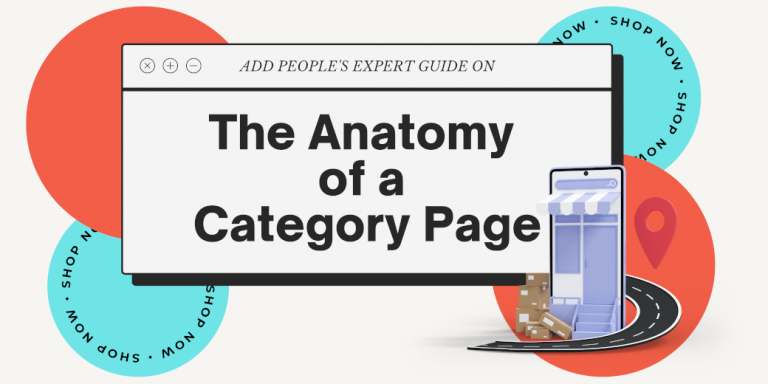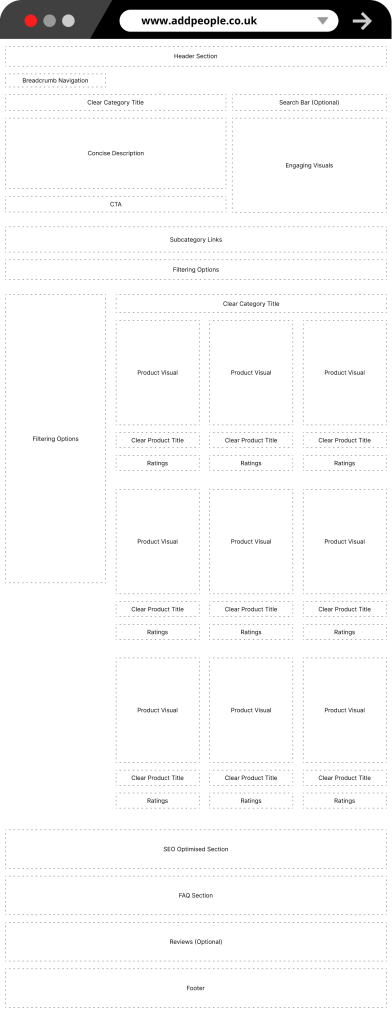
In this guide, we’ll take a deep dive into the key fundamentals that create a powerful and persuasive category page. We’ll explore the secrets of crafting an effective category page that not only captures attention but also drives high conversions.
To make things even better, we’ve included a practical category page design layout template at the end, which you can easily apply to most e-commerce platforms.
The Key Fundamentals of a Category Page
Are you aiming to design a flawless category page that captivates users and maximizes conversions? Look no further! Below, we’ve compiled all the essential elements that must be incorporated into a perfect category page.
1. Clear Title
On a category page, a clear title plays a crucial role in providing users with a concise description of the products available. It helps them assess if the page aligns with their requirements.
By incorporating targeted keywords, the title enables users to swiftly identify relevant sections. For instance, a title like “Men’s Running Shoes” immediately signifies a product range specifically designed for men, while “Home Decor: Wall Art & Paintings” draws attention to decorative artwork suitable for embellishing walls.
Well-crafted titles not only enhance the overall user experience but also contribute to search engine optimization (SEO). They appear in relevant search results, increasing visibility and attracting potential customers to the website.
2. Well Structured Layout
A well-structured layout on a category page is vital for a smooth user experience. Whether using a grid or list view, an organised layout allows users to easily scan through options, compare products, and find what they’re looking for without generating any confusion.
In a grid view, users can quickly compare visual elements like images and designs, while a list view provides detailed information for decision-making. Consistency in displaying product information is important, and incorporating filtering and sorting options further enhances the user experience by enabling users to refine their search.
Overall, a well-structured layout ensures efficient navigation and helps users find desired products effortlessly.
3. Captivating Visuals
When it comes to a category page, captivating visuals are a must-have as they play a vital role in attracting users and igniting their curiosity to explore. The inclusion of high-quality product images that showcase various angles is key, allowing users to zoom in for a closer examination.
By offering such captivating visuals, we elevate the overall shopping experience, establishing trust and enticing users to delve deeper into the products. Professional photography, appropriate lighting, and consistent image presentation throughout the page all contribute to the visual appeal.
To further engage users, interactive elements such as videos or 360-degree views can be incorporated. These engaging visuals ultimately generate greater user interest, elevate the shopping experience, and increase the likelihood of successful conversions.
4. Descriptive Product Names
Implementing descriptive product names is extremely important when it comes to a category page. These names carry essential information such as the brand, model, and distinctive features of the products. They play a crucial role in helping users quickly identify the items they’re looking for, while also assisting search engines in effectively organising and ranking the page.
Clear and concise names not only save users valuable time but also contribute to their decision-making process. Moreover, maintaining consistency in naming conventions enhances the overall user experience and fosters a sense of trust.
By crafting well-thought-out product names, we can optimise the visibility of the page on search engines and drive organic traffic to the category page, ultimately benefiting both users and the website.
5. Concise Descriptions
Including concise descriptions for each product on a category page is incredibly important. These descriptions play a vital role in showcasing the key features, specifications, and benefits of the products, helping users make well-informed assessments. They provide just the right amount of information for users to make initial decisions and encourage further exploration.
By highlighting important details without overwhelming users, concise descriptions greatly enhance the browsing experience and make product comparisons more efficient.
Moreover, they effectively communicate the value proposition and unique selling points of each product. Ultimately, these concise descriptions contribute to increased user engagement, and higher conversion rates, and facilitate effective product selection on the category page.
6. Filtration Options
Having sorting and filtering options on category pages is absolutely essential for enhancing the shopping experience. Sorting options provide users with the ability to arrange products based on factors like price, popularity, or relevance, allowing them to find what they’re looking for more easily.
Filtering options, on the other hand, enable users to refine their search by selecting specific criteria such as size, colour, brand, and ratings. These features greatly streamline product navigation, saving users valuable time and ensuring a personalised product selection process.
By offering sorting and filtering options, category pages significantly improve user engagement, efficiency, and overall satisfaction, ultimately leading to successful purchases.
7. Ratings & Reviews
Ratings and reviews on a category page add credibility, inform purchasing decisions, and enhance the shopping experience. Average ratings give a quick snapshot of product satisfaction, while customer reviews provide detailed feedback.
They build trust, offer transparency, and foster a sense of community engagement. Implementing moderation ensures credibility. Overall, ratings and reviews contribute to informed decision-making and a more trustworthy shopping experience.
8. Categories & Subcategory Links
Related categories or subcategories links on a category page enhance browsing experience by allowing users to explore additional product options. These links encourage users to discover related products, increasing the likelihood of finding what they need.
Strategic placement and organisation ensure seamless transitions and allow for cross-selling and upselling opportunities. By providing a seamless browsing experience, related category links promote user engagement, satisfaction, and higher conversions.
9. Search Bar
A prominently visible search bar at the top of the category page allows users to search for specific products or brands. It should provide relevant suggestions and auto-completion features, simplifying and expediting the search process.
This user-friendly feature enhances the overall browsing experience and helps users find products quickly and efficiently. Although not necessary on a category page since it would already be included within the header, it would not be a bad idea to optionally include a sub-section search within said page.
10. Breadcrumb Navigation
Breadcrumbs display the user’s current location within the website’s hierarchy and enable easy navigation back to previous pages. They provide context & improve website structure understanding. Breadcrumbs also contribute to intuitive navigation and help users explore different categories without losing progress.
Additionally, they benefit search engine optimization (SEO) by improving website visibility and ranking. Breadcrumbs optimise usability, enhance navigation, and create a more intuitive browsing experience.
11. SEO Optimised Section
An SEO section on a category page is all about optimising different elements to improve visibility in search engines. It involves doing keyword research, optimising meta tags, structuring URLs, using heading tags effectively, and creating relevant content.
By implementing these strategies, the category page becomes more likely to rank higher in search results and attract organic traffic, ideally from customers who are looking for the desired product.
12. FAQ Section
The FAQ section is a valuable resource that addresses common user questions and provides helpful information. It saves time by offering concise answers to frequently asked questions, enhancing the user experience and fostering trust.
Organised and regularly updated, the FAQ section aids in informed decision-making and contributes to customer satisfaction.

13. Category Design Template
To the left, you can find a design template we’ve put together to give you an idea of what a category page that incorporates all of these elements could and should look like.
. . . . . . . . . . . . . . . . . . . . . . . . . . . . . . . . . .
Looking for something else? If this doesn’t sound like the marketing service for you, then don’t worry. We have plenty more to offer small to medium-sized businesses like yourself.
👉 Are people not buying what your eCom business is selling? Let our eCommerce team help!
👉 Need to tap into audiences of millions and develop your brand? Look no further than our social media team!
👉 Does your website need a facelift to look, run and convert better? Lean on our decades of site development and design experience!
👉 Want to target customers with an ad right when they’re ready to convert? Our PPC team can help you pounce!
👉 Struggling to draw visitors and conversions with your website? Our SEO services are fine-tuned for you!
